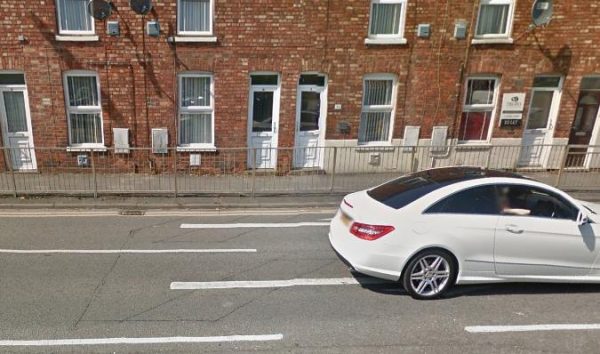It’s important to keep traffic flowing on main roads and to interrupt that traffic only when there are vehicles waiting to enter from a side road. This is one of the main uses for induction loops embedded in the road: they detect when a vehicle has passed or is sitting above it and can send a message to the traffic light signals to turn the lights red on the main road and green on the side road. They don’t detect vehicle pressure; they register that a large metal object has passed over the top by the disturbance in the electromagnetic field in the loop.

The diagonal lines on the road show the cuts where the induction loop is laid on Botolph Street in Boston, Lincolnshire
The loops can be seen at most traffic lights – look for straight cuts in the road, as shown in the image above. Roading contractors will cut a narrow trench in the road in a loop. In the image above they are shaped like a parallelogram, but they could equally be a rectangle. Wire is laid in the loop and this is connected to a box on the side of the road. Power is fed through the wire and the large metal objects (i.e cars and lorries) passing over the wire causes a fluctuation in the electrical field. This is detected and sent to the traffic light controller which then knows that there’s a vehicle waiting to turn.
Induction loops can also be used to lengthen phases. If loops are placed back up the road they can detect if there are long queues forming and it can hold the green light for longer. Of course, this only works if the vehicles have somewhere to go, which is where advanced traffic management comes in.
In the case of metering traffic onto motorways, induction loops can lengthen or shorten the traffic light phases.
Loops can also be used to approximate the approach speed of traffic. If two loops are used with a preset distance then the difference in the time each one is triggered can be used to calculate a vehicle’s speed.
The loops have a preset time that they wait until they register that the vehicle is there (usually about 4 seconds) which is why traffic lights don’t change immediately when you arrive. This also gives other vehicles a chance to stack up behind the leading vehicle meaning that more traffic gets through when the light turns green. This delay is also why if you arrive at a red right-turn filter light you won’t always get the green filter light on that phase.
Problems with induction loops
Sometimes they don’t detect bikes and small motorbikes. If you’ve ever sat for a while waiting for the lights to change and then they change when another car or lorry arrives behind you, this is what’s happened. Riders should ensure that the bulkiest part of their bike is positioned along one of the cut lines as this will affect the electromagnetic field the most.
